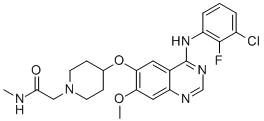
AZD8931 is an equipotent, reversible inhibitor of Signaling by EGFR, ERBB2 (HER2), and ERBB3 with IC50 of 4, 3, 4 nM, respectively. AZD8931 was significantly more potent than gefitinib or lapatinib in specific squamous cell carcinoma of the head and neck and non–small cell lung carcinoma cell lines. In vivo, AZD8931 inhibited xenograft growth in a range of models while significantly affecting EGFR, erbB2, and erbB3 phosphorylation and downstream signaling pathways, apoptosis, and proliferation. AZD8931 provides the opportunity to investigate whether simultaneous inhibition of erbB receptor signaling could be of utility in the clinic, particularly in the majority of solid tumors that do not overexpress erbB2.
| Cell Experiment | |
|---|---|
| Cell lines | a panel of NSCLC and SCCHN cell lines: KYSE-30, OE21, PE/CA-PJ15, PE/CA-PJ34 (clone C12), PE/CA-PJ41 (clone D2), PE/CA-PJ49, DOK, Detroit562, RPMI2650, SCC-4, SCC-9, SCC-25, CAL 27, SW579, FaDu, Hs 840.T, KB, KYSE-450, and HEp-2, HN5; PC-9, Calu-3, NCI-H2073, NCI-H1623, NCI-H522, NCI-H2085, NCI-H2030, NCI-H1703, NCI-H2291, NCI-H2135, NCI-H1975, NCI-H23, NCI-H1650, NCI-H1437, NCI-H3255, and NCI-H1666 cell lines |
| Preparation method | cell viability assay. To determine their antiproliferative activity against cell lines grown in vitro, AZD8931, gefitinib, and lapatinib were tested in a panel of NSCLC and SCCHN cell lines. Cells were incubated for 96 h with a suitable range of concentrations of drug to ensure accurate estimation of the inhibitor concentration required to give 50% growth inhibition (GI50; typically between 0.001-10 μmol/L). Viable cell number was determined by 4 h of incubation with MTS Colorimetric Assay reagent (Promega) and absorbance measured at 490 nm on a spectrophotometer (Molecular Devices). Each experiment was carried out in triplicate for each drug concentration and data are presented as geometric means. Sensitivity groupings of GI50 data were <1 μmol/L (classed as sensitive), 1 to 7 μmol/L (classed as intermediate), and >7 μmol/L (classed as resistant). |
| Concentrations | 0~10μM |
| Incubation time | 96 h |
| Animal Experiment | |
|---|---|
| Animal models | BT474c, Calu-3, LoVo, FaDu and PC-9 xenograft mouse models |
| Formulation | suspended in a 1% (v/v) solution of polyoxyethylenesorbitan monooleate (Tween 80) in deionized water |
| Dosages | 6.25-50 mg/kg twice daily |
| Administration | oral gavage |
| Molecular Weight | 473.93 |
| Formula | C23H25ClFN5O3 |
| CAS Number | 848942-61-0 |
| Solubility (25°C) | DMSO 40 mg/mL |
| Storage |
Powder -20°C 3 years ; 4°C 2 years In solvent -80°C 6 months ; -20°C 1 month |
| Species | Mouse | Rat | Rabbit | Guinea pig | Hamster | Dog |
| Weight (kg) | 0.02 | 0.15 | 1.8 | 0.4 | 0.08 | 10 |
| Body Surface Area (m2) | 0.007 | 0.025 | 0.15 | 0.05 | 0.02 | 0.5 |
| Km factor | 3 | 6 | 12 | 8 | 5 | 20 |
| Animal A (mg/kg) = Animal B (mg/kg) multiplied by | Animal B Km |
| Animal A Km |
For example, to modify the dose of Compound A used for a mouse (20 mg/kg) to a dose based on the BSA for a rat, multiply 20 mg/kg by the Km factor for a mouse and then divide by the Km factor for a rat. This calculation results in a rat equivalent dose for Compound A of 10 mg/kg.
| Related EGFR/HER2 Products |
|---|
| BBT-207
BBT-207 is a reversible, mutant-specific EGFR inhibitor with antitumor activity. |
| VRN-11
VRN-11 is an EGFR C797S inhibitor. |
| TRX-221
TRX-221 is an EGFR C797S inhibitor. |
| TAS-3351
TAS-3351 is an EGFR C797S inhibitor. |
| Larotinib mesylate hydrate
Larotinib mesylate hydrate is a potent, broad-spectrum, orally active tyrosine kinase inhibitor (TKI) that primarily targets EGFR with an IC50 of 0.6 nM. |


Products are for research use only. Not for human use. We do not sell to patients.
© Copyright 2010-2023 AbMole BioScience. All Rights Reserved.
